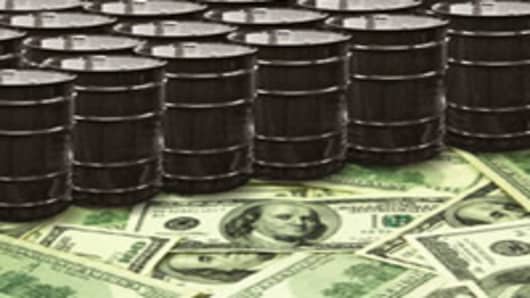The rise in oil prices could be just getting started, posing opportunities for investors—as well as challenges for consumers and hopes for US economic growth.
Consensus estimates are for oil pricesto rise to the $100-a- barrel range for 2010, a base case that would reflect a steady pace of economic growth. In an optimistic scenario, gains of that nature merely would reflect growth in the US economy and would not pose an obstacle to what is expected to be a more sustained pace of recovery.
But anything beyond that, such as the estimate from Bank of America Merrill Lynch on Monday for $120 a barrel in 2011, could spell danger.
"At current levels, a gradual increase of $10 a barrel over the next couple of years is no big deal for the global economy," said Zach Pandl, economist at Nomura Securities in New York. "But a repeat of anything like we had in 2008, or even a rise of a fraction of that size, could put a dent in the recovery."
Oil hit its historic high of $147 a barrel in mid-July 2008. That was as the worst of the credit crisis was spreading, stocks were tanking, the dollar was dropping and speculators were looking for someplace to get return on their money. But by December of that year, oil had tanked below $40 a barrel as the global economy could no longer support surging oil prices.
Since then, crude has found some sense of equilibrium, wading now in the $80-$90 range but after a healthy 13 percent gain for the year. The global growth story, along with weakness in the US dollar, is likely to put more upward pressure on oil prices ahead, driving a variety of opportunities for investors to capitalize.
"We have been bullish on energy stocks, and an improving trend for crude oil prices may provide further support for higher prices in the stocks," BofA technical research analyst MaryAnn Bartels wrote in a research note for clients. "The technicals for crude oil are bullish and we can project a measured move to $118-120. We continue to recommend exposure to the energy sector across all groups."
The opinion is widely shared across the industry, as strategists ratchet up their forecasts across a variety of asset classesand in particular oil and stocks.
Goldman Sachs has targeted an average price of $100 a barrel and a high of $105, about where Nomura is as well. Goldman is overweight the sector and has buy ratings on stocks such as Schlumberger and Occidental Pete in exploration, and notes hedge fund movements into integrated companies such as Chevron and Murphy Oil .
JPMorgan has pegged oil as the asset class with the highest returns in 2010, with "high conviction" ratings on oil services and equipment as well as integrated oil and gas. It has recently increased its rating on the sector to "overweight."
"Long term, energy is a secular story of favorable supply/demand dynamics: production is increasingly expensive...while demand tracks overall global economic growth, which means demand rises long term," JPMorgan chief equity strategist Thomas J. Lee wrote in his 2011 outlook. "In the short term, we see strong fundamental trends and a positive outlook driving outperformance of the sector..."
In addition to global growth, geopolitical tensionsalso are expected to play a part in oil's rise. Barclays Capital predicts "a greater degree of geopolitical risk over the next 12 months than for some time."
"Nigeria is the most immediate physical supply disruption risk because of its April 2011 elections," the firm wrote in a forecast. "Iraq (due to the withdrawal of US troops and failure to get a political settlement) and Iran (where further conflict is likely regarding nuclear issues) present less immediate, but potentially very significant, risks to oil supply over the next 12 months."
Still, despite all those expectations of rising prices, the threat to consumers right now is seen as only moderate.
Peter Cardillo, chief economist at Avalon Partners in New York, predicts an average oil price of $95 for 2011 with a possible spike above $100. With average prices now for regular unleaded gas at $2.98 a gallon nationwide, that type of increase in oil could drive prices to $3.70 a gallon, he said.
But he also does not see that level as an impediment to economic recovery, predicated on growth continuing and the recent agreement in Washington over extending the current marginal tax rates.
"If we were to get to $140 or $150, then that you could consider a tax burden for the consumer," Cardillo said. "But I don't think it will spike up there. On average it will be less than $100. I don't think that's going to have an impact on economic activity."



